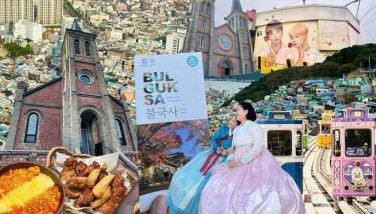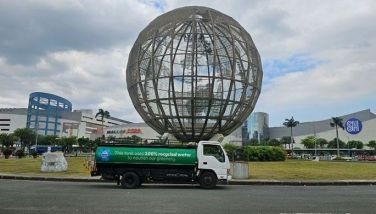Milan’s finest Cafés
July 2, 2005 | 12:00am
 Not too long ago, it was difficult to find a good cup of java in Manila. But the explosive growth of coffee culture has spawned countless cafés around the metropolis. Most of the credit goes to Starbucks, who pioneered the trend when they opened their first outlet at 6750 Ayala. During the opening, some people even came in designer gear as if it were a new bar or dance club. American chains such as Starbucks, Seattle’s Best and Coffee Bean & Tea Leaf have done a remarkable job of educating customers and establishing coffee culture in recent years.
Not too long ago, it was difficult to find a good cup of java in Manila. But the explosive growth of coffee culture has spawned countless cafés around the metropolis. Most of the credit goes to Starbucks, who pioneered the trend when they opened their first outlet at 6750 Ayala. During the opening, some people even came in designer gear as if it were a new bar or dance club. American chains such as Starbucks, Seattle’s Best and Coffee Bean & Tea Leaf have done a remarkable job of educating customers and establishing coffee culture in recent years.
But while these chains have forged ahead, it leaves one wanting for the individuality of independent cafés found in many world cities. In a way, cafés have become the equivalent of a Marriott or a Hilton. You could be in Shanghai or in Madrid but when you’re in a coffee-chain store, it’s the same experience everywhere. I don’t mean to knock the big chains, as they serve pretty good coffee. It’s just that while traveling, I like to immerse myself in the culture of the place I’m visiting. I prefer the eccentricities and imperfection of a boutique hotel over a homogenized Hyatt. A great way to survey the soul of a city is to visit its local cafés.
I recently spent some time in Milan and had the chance to explore its many coffee houses. Italy is world-renowned for its coffee culture and it was a pleasure to wander through the city’s uniquely special café spaces.
Coffee houses are said to have originated in Persia in the 16th century. It was a place where men gathered to discuss important matters over pots of the bitter black brew. The spread of Islam and the trade between East and West eventually brought coffee to Europe. Around 1570, the first coffee shop in Italy was established in Venice. Like many new inventions, the Church was apprehensive of the new drink, forbidding the faithful from imbibing what they called "the devil’s beverage." Pope Clement VII tried the potion himself and declared that it was "so delicious that it would be a sin to let only misbelievers drink it!," thus making it a drink fit for Christians as well. By the late 18th century, cafés were to be found in every town throughout Italy.
Like Manila, Milan was carpet-bombed during World War II, leveling the city and destroying most of its architectural heritage. The city is not as overtly beautiful as Venice or Florence, but its grace is more slowly revealed as one discovers its many secrets. There are a number of historical cafés scattered throughout the city, and here are some of the best ones.
Perhaps the most well known Milanese caffé is Caffé Cova at 8 Via Montenapoleone. Established in 1756, Caffé Cova is located near La Scala, although this is actually the second incarnation of the café. It’s bang in the center of Milan’s most famous shopping street and part of the Quadrilatero d’Oro that is home to the modern-day palazzos of Armani, Prada, Valentino, Ferre and Dolce & Gabbana. Caffé Cova is filled with antique furniture and its walls are lined with correspondence from its highly distinguished clientele. Its refined ambience and enormous success have led to more Covas being built in such far-off places as Hong Kong and cruise liners.
Within the Galleria Vittorio Emmanuele, Milan’s famous shopping mall, is Caffé Zucca. A stone’s throw from La Scala Opera House, Zucca’s regulars included the composer Giuseppe Verdi and the conductor Arturo Toscanini. It was built in 1867 concurrent with the Galleria and its Art Deco design is faithfully preserved. It has an impressive wooden inlaid bar, wrought-iron chandeliers and a mosaic mural typical of the period. It’s an excellent place to take an espresso to cool your heels and your credit card.
Away from the historic center, in the up-and-coming neighborhood of Porta Genova, is Caffé Cucchi. Situated in a charming piazza, you’ll find elegant Milanese sipping coffee while reading the day’s Corriere della Sera. Inside Cucchi is a display case of heavenly pastries and a coffee bar with three formidable baristas. As I stood by the bar, I overheard patrons ordering a multitude of coffee drinks I had never heard of. The most interesting was a Marocchino, an espresso served in a shot glass lined with chocolate and topped with cream. Cucchi is a great place to witness the real Milan, away from the touristy Centro. It is also within striking distance of Biffi, a well-guarded Milanese fashion secret.
While Italy is rooted in centuries of history, Milan is best known for setting global trends in the world of fashion and design. A number of new cafés have sprouted around the city and all of them are spaces worth visiting. At the Triennale, an impressive museum devoted to architecture and design, there is a wonderful café called Coffee Design. It is a pure white space that overlooks the museum’s courtyard. Each of the café’s 30 or so chairs is a modern design icon. You’ll find an entire spectrum of chairs – from a vintage Gio Ponti to a Sixties Verner Panton to more contemporary examples by Jasper Morrison and the Bouroullec brothers. The café also sells handy picnic boxes that you can take with you to the adjacent Parco Sempione for a snack in the park.
Back at the Galleria Vittorio Emmanuele, there is the brand-new Gucci Caffé. The only one of its kind in the world, it is a beautiful space next to the flagship store and makes for a convenient respite from the temples of fashion around it. Order an espresso and your Gucci-clad waiter will bring you a perfectly brewed cup served in custom-made porcelain, a shot of sparkling water, a double "G" logo chocolate made by local pâtissier Ernst Knam, and a bespoke Gucci teaspoon. The stark contrast of the sleek, modern café and the grand, old-world elegance of the Galleria is simply magnificent.
The third contemporary café I visited was Princi, at Piazza Aprile XXV, 5. Princi is a renowned local bakery and has several locations around the city. But it is at this flagship where its owner, Rocco Princi, decided to make a statement. Princi commissioned the architect Claudio Silvestrin to create a grand theater for the baking arts. Silvestrin shunned the practice of keeping bakers hidden from view, and placed them right at the streetfront, where passersby can marvel at the Armani-clad artists creating more than 200 varieties of special breads (only in Milan will you find bakers and policemen dressed in Armani, as the carabinieri at Via Montenapoleone are). The walls of the café are clad in a special type of oxidized brass and a dark, rough-hewn Roman stone. The breads are exquisitely displayed and are truly elevated to become edible objets d’art. Outside there is an open-air café that is perfect for people watching the city’s glamorous citizenry.
Two other café spaces worth visiting are the garden terrace at the Bulgari Hotel and the lobby of the Park Hyatt. Both are stunning spaces designed by the architects Antonio Citterio and Ed Tuttle, respectively. These two new hotels are stunning, but that’s a whole other article altogether.
BrandSpace Articles
<
>




















